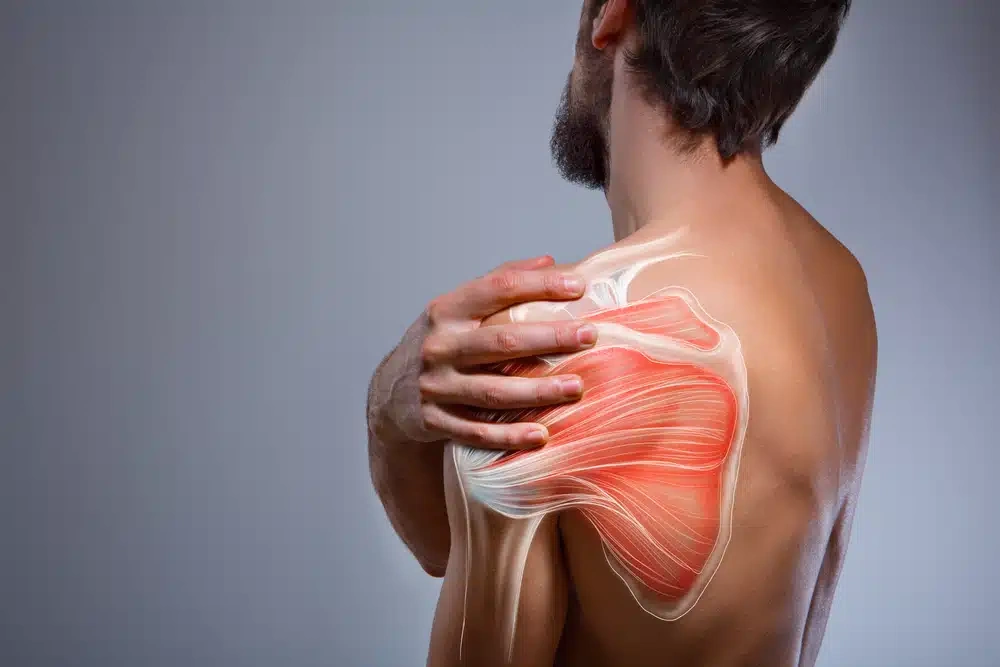You know that odd, nagging pain in upper right arm between elbow & shoulder that just kind of… lingers? Sometimes it’s sharp, sometimes it’s dull — maybe it wakes you up at night or nags quietly when you reach for a coffee mug. It might start as a small tug near your shoulder joint and then, for reasons you can’t quite place, crawl down toward the elbow. The body’s way of saying “hey, something’s off,” but not always telling you what.
The truth is, that upper arm region — where your shoulder muscles, tendons, and nerves all mingle — is a bit of a crossroads. There’s the rotator cuff doing its delicate balancing act, the biceps tendon sliding and stabilizing, and peripheral nerves weaving down toward your forearm. So when even one part gets irritated — from overuse, poor posture, or just life being awkward — the pain can feel confusingly spread out.
Maybe you’ve lifted something awkwardly, or maybe you’ve been sitting too long with your shoulders hunched toward your keyboard. Even emotional tension (yes, really) can make muscles tighten and reduce your range of motion. Whatever the reason, that throbbing or burning ache in your upper arm isn’t random. It’s a signal. Sometimes a small one, sometimes a louder one.
Pain in Upper Right Arm Between Elbow & Shoulder
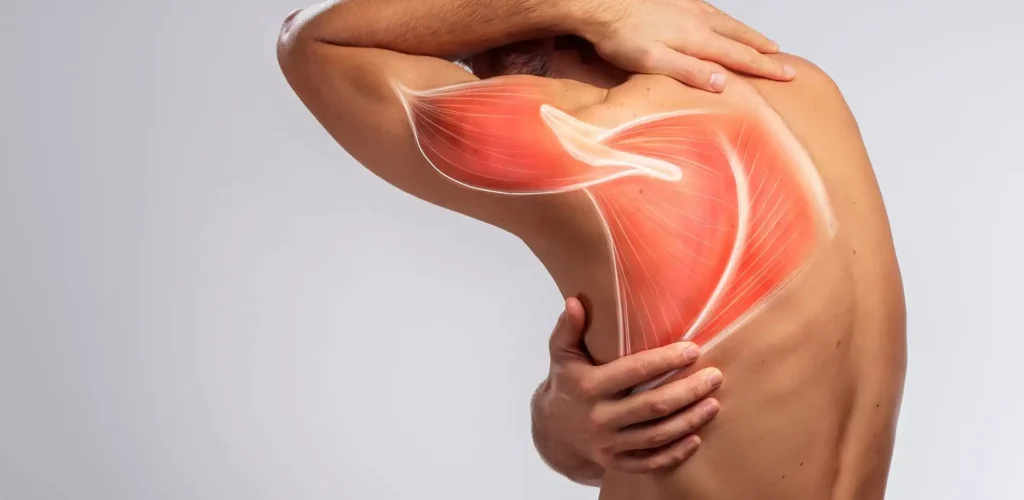
Understanding what’s actually in there — the structure behind that pain in upper right arm between elbow & shoulder — makes the whole mystery less frustrating. Your upper arm is a mix of muscle layers, tendons, nervous system, and bones all working in perfect sync… until one doesn’t.
You’ve got your deltoid sitting on top, responsible for lifting and rotating your arm. Beneath that, the biceps (front) and triceps (back) handle flexion and extension, the everyday bending and straightening. The rotator cuff muscles — a group of four — stabilize your shoulder joint, keeping the humeral head (the upper arm bone) aligned inside its socket.
And somewhere in that busy space, the biceps tendon and brachial plexus nerves travel through tight tunnels, easy to irritate but tricky to pinpoint when they’re the culprit.
This region is so injury-prone because it’s constantly in motion. Every push, pull, reach, or swipe you do involves these muscles — and modern habits (tech-neck, repetitive strain from typing, sleeping wrong) can lead to microtears, impingement, or nerve compression.
Here’s a quick glance at what connects the dots:
| Structure | Function | Common Issue |
| Deltoid Muscle | Lifts and rotates the arm | Overuse strain, poor posture fatigue |
| Rotator Cuff | Stabilizes shoulder joint | Tendinitis, small tears, impingement |
| Biceps Tendon | Flexes elbow, stabilizes shoulder | Tendinitis, subacromial pain syndrome |
| Triceps | Extends elbow | Overload or muscle imbalance |
| Brachial Plexus Nerves | Transmit signals from neck to arm | Compression, neuritis, tingling sensations |
You can think of it as an orchestra — every muscle and nerve has its role. But when one “instrument” plays off-key (say, your rotator cuff tendons get inflamed), the whole performance feels off — in the form of pain, weakness, or limited range of motion.
Pro Tip 🎯: Next time your shoulder or upper arm aches, stand in front of a mirror and slowly raise your arm sideways. Notice if one side moves differently, hesitates, or feels heavy. That imbalance might hint at a deeper shoulder impingement or early rotator cuff irritation.
I. Cause #1: Muscle Strain or Overuse
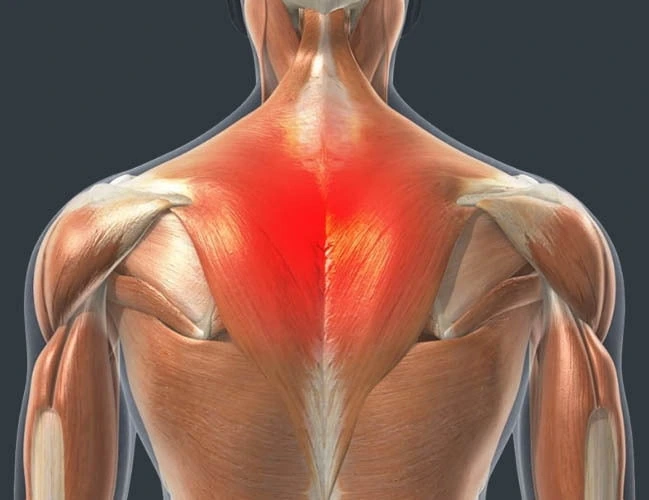
Sometimes, the pain in upper right arm between elbow & shoulder isn’t mysterious at all — it’s just your muscles waving a tiny red flag after doing too much. Maybe you carried groceries in one arm, maybe your last gym session got a little too ambitious, or maybe it’s been weeks of repetitive motions that seemed harmless at the time.
Muscle strain or overuse is one of the most common culprits of upper arm pain. The biceps and deltoid muscles, along with smaller stabilizers like the rotator cuff tendons, can all tighten or tear microscopically when overworked. The result? A dull ache that flares when you move, sometimes paired with stiffness or swelling.
You might notice:
- A deep, sore ache after lifting or reaching overhead
- Tightness near the shoulder joint or upper arm muscles
- Limited range of motion or discomfort during simple tasks
- Mild swelling or warmth in the affected area
If that sounds like you, don’t panic — most mild strains heal with rest, gentle stretching, and ice therapy. But ignoring it can turn a simple overuse issue into chronic rotator cuff tendinitis or shoulder impingement syndrome.
Here’s a quick self-care guide:
| Phase | What to Do | Why It Helps |
| Rest (1–3 days) | Avoid heavy lifting, overhead activity | Reduces inflammation and prevents further tearing |
| Cold Therapy (10–15 min) | Apply an ice pack several times a day | Minimizes swelling and numbs pain |
| Gentle Stretching | Shoulder blade squeezes, towel stretches | Restores flexibility and blood flow |
| Gradual Strengthening | Light resistance bands, isometric holds | Prevents muscle weakness or future strain |
Pro Tip 💪: When you get back to exercise, think “form over force.” Poor movement patterns (especially during pressing or pulling exercises) are what most often lead to biceps tendon pain or upper arm strain. Listen to your body — pushing through pain isn’t strength; it’s stubbornness disguised as progress.
II. Cause #2: Rotator Cuff Tendinitis or Tear
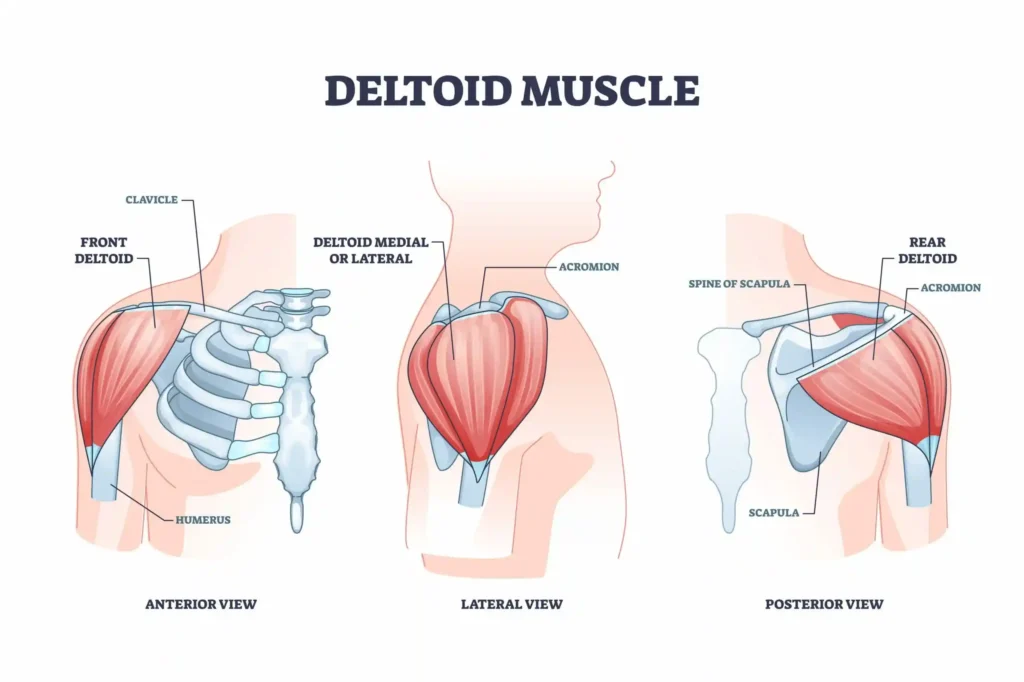
Now, if the pain in upper right arm between elbow & shoulder feels sharp when you lift your arm, especially overhead — or it radiates down from your shoulder blade toward your biceps — that could point to a rotator cuff issue. These tendons keep your shoulder joint stable, but they’re also fragile, easily irritated by repetitive motions like swimming, painting, or even reaching behind you awkwardly.
When those rotator cuff tendons become inflamed (rotator cuff tendinitis) or develop small tears, you’ll often feel a deep, nagging ache around the shoulder joint, sometimes spreading halfway down the upper arm. It’s worse at night or when you try to sleep on that side — and you might even hear or feel a faint clicking or catching sensation when you move.
Common signs of rotator cuff injuries:
- Pain when raising or rotating your arm
- Weakness lifting light objects
- Limited range of motion (can’t reach behind your back)
- Pain worsening at night or after repetitive strain
- Tenderness around the shoulder blade area
Most mild cases respond well to physical therapy, rest, and nonsteroidal anti-inflammatory drugs (NSAIDs). A physical therapist might guide you through shoulder exercises — such as external rotations, doorway stretches, or isometric holds — to help strengthen the rotator cuff muscles and restore balance.
Here’s what recovery might look like:
| Stage | Recommended Treatment | Purpose |
| Acute Phase | Ice pack, pain relievers, rest | Reduce swelling and pain |
| Rehabilitation | Physical therapy, stretching, ergonomic training | Restore shoulder mobility |
| Maintenance | Strength training, posture correction, soft tissue mobilization | Prevent reinjury and maintain range of motion |
Pro Tip 🩻: If the pain lingers for more than a few weeks or limits daily movement, ask your doctor about imaging — an MRI or ultrasound can confirm whether it’s rotator cuff tendinitis, a partial tear, or a case of shoulder impingement syndrome. Early detection can mean the difference between simple rehab and potential orthopedic surgery.
III. Cause #3: Biceps Tendinitis
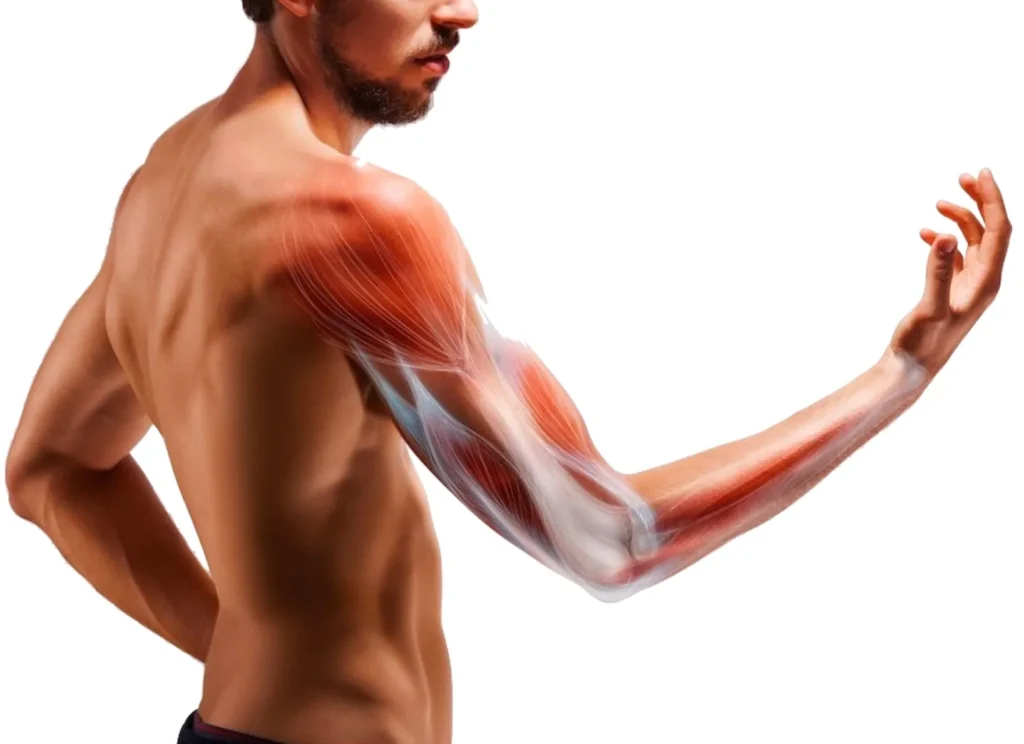
If your pain in upper right arm between elbow & shoulder feels sharp at the front — right where your biceps muscle meets your shoulder — that’s a telltale sign of biceps tendinitis. It’s surprisingly common among people who lift weights, play tennis, or even those who spend hours typing with their arms slightly elevated (yes, desk strain counts too).
This condition happens when the biceps tendon, which connects your biceps muscle to the shoulder joint, becomes inflamed or irritated. Over time, this small tube-like tendon rubs against surrounding structures — especially if the rotator cuff tendons are tight — leading to friction, pain, and sometimes a faint clicking when you move your arm.
You’ll usually notice:
- A deep ache in the front of your shoulder or upper arm
- Pain when you lift, reach, or rotate your arm outward
- Weakness when bending the elbow
- Tenderness when you press near the bicipital groove (that little dip at the front of your shoulder)
Here’s something interesting: people often mistake biceps tendinitis for shoulder impingement or even rotator cuff injuries — because the pain overlaps. But biceps tendinitis tends to radiate more down the arm, while rotator cuff pain often stays near the shoulder blade or side of the upper arm.
Quick Comparison Table:
| Feature | Biceps Tendinitis | Rotator Cuff Tendinitis |
| Pain Location | Front of shoulder/upper arm | Side or back of shoulder |
| Movement Pain | Elbow flexion, lifting | Raising arm overhead |
| Sound/Sensation | Clicking or snapping | Dull ache, stiffness |
| Treatment | Rest, ice, physical therapy | Rest, stretching, anti-inflammatory care |
Treatment usually starts conservatively — ice packs, nonsteroidal anti-inflammatory drugs (NSAIDs), and gentle mobility work like doorway stretches or shoulder blade squeezes. But if pain persists, doctors might recommend corticosteroid injections or instrument-assisted soft tissue mobilization (IASTM) to help reduce inflammation and restore smooth tendon movement.
Pro Tip 🩺: When returning to activity, avoid exercises that overuse your biceps tendon — like heavy curls or upright rows. Focus on posture correction, strengthening the rotator cuff muscles, and slow, controlled movements to protect the joint. Think of it less as “training harder” and more like training smarter.
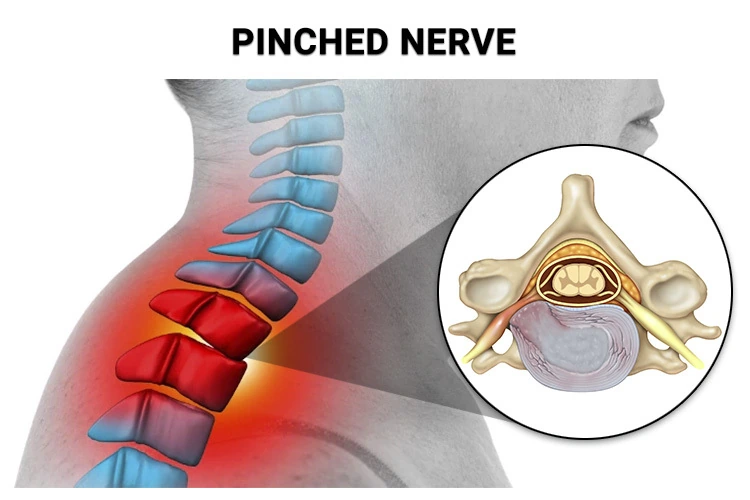
IV. Cause #4: Nerve Compression or Pinched Nerve
Here’s where things get tricky. Sometimes that pain in upper right arm between elbow & shoulder has nothing to do with muscles or tendons at all — it’s actually your nerves calling for help. Specifically, the ones branching out from your cervical spine (neck) and traveling through the brachial plexus down your arm.
When these peripheral nerves get compressed — whether from a herniated disk, poor posture, or muscle tightness — they can trigger radiating pain that feels electric, tingly, or burning. It’s a different sensation from muscle soreness; it’s sharper, more shooting. Some even describe it as “pins and needles” or a feeling of weakness spreading from the shoulder to the forearm.
Common causes of nerve compression:
- Cervical radiculopathy: A nerve root pinched in the neck, often from a herniated disk or arthritis.
- Thoracic outlet syndrome: Compression between the collarbone and first rib, common in athletes or desk workers.
- Repetitive strain or poor ergonomics: Continuous tension from “tech-neck” or slouching.
- Brachial neuritis: Inflammation of the brachial plexus, sometimes following infection or injury.
If nerve compression is the issue, resting the muscles alone won’t help — because the problem starts higher up, often near the neck or shoulder blade. A physical therapist may guide you through nerve gliding exercises or therapeutic stretches that release tension and restore normal signal flow.
Here’s how to spot the difference:
| Type of Pain | Feels Like | Possible Cause | What Helps |
| Burning or Tingling | Radiates down arm | Pinched nerve, nerve irritation | Posture correction, neck stretches |
| Deep Dull Ache | Localized in upper arm | Muscle strain, tendonitis | Ice, rest, massage |
| Sharp Shooting Pain | Sudden, electric | Cervical radiculopathy | Physical therapy, ergonomic training |
Pro Tip ⚡: If your pain worsens when you tilt your head or look down at your phone, it’s probably nerve-related. Try taking frequent posture breaks — roll your shoulders, gently stretch your neck, and keep screens at eye level. Sometimes, relief comes from something as small as changing how you sit.
V. Cause #5: Bursitis (Shoulder or Upper Arm)
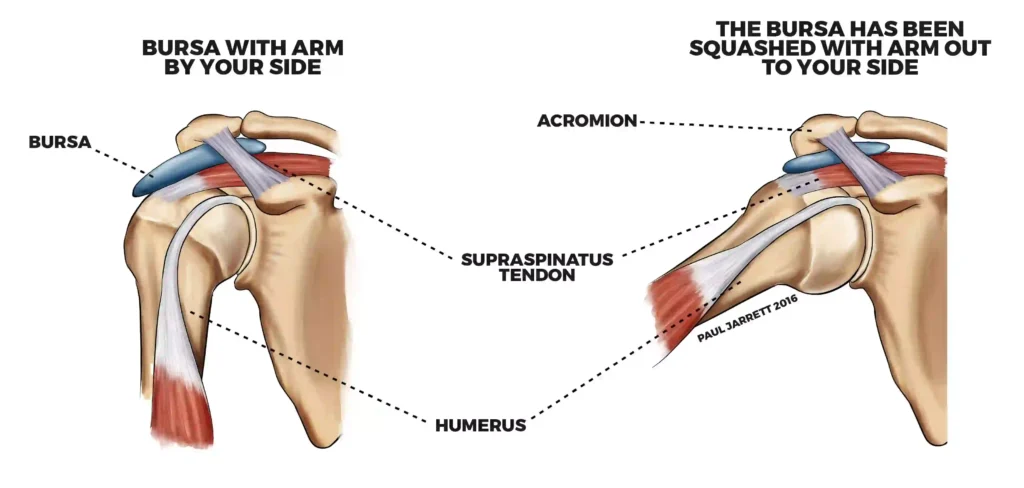
Sometimes, your pain in upper right arm between elbow & shoulder isn’t coming from a strained muscle or an angry nerve — it’s from a tiny little cushion you’ve probably never thought about: the bursa. These small, fluid-filled sacs reduce friction between bones, tendons, and muscles. But when they get inflamed — a condition called bursitis — even the simplest motion can sting.
In the shoulder joint, bursitis often affects the subacromial bursa, located between your rotator cuff tendons and the acromion (the top part of your shoulder blade). Too much overhead movement, repetitive reaching, or poor posture can irritate it. Before long, you’re feeling stiffness, swelling, and that deep, sore ache spreading across your upper arm.
You might notice:
- Pain that worsens when lying on the affected side
- Tenderness around the top of the shoulder
- A stiff or swollen feeling near the deltoid area
- Difficulty lifting your arm above shoulder height
And unlike a muscle strain that improves with stretching, bursitis tends to flare up with movement — which can make it tricky to manage on your own.
Common triggers of shoulder bursitis:
- Repetitive motions (painting, swimming, typing)
- Poor posture or shoulder impingement
- Sports injury or heavy lifting
- Aging and degenerative shoulder conditions
Treatment approach:
| Step | Home Remedies | Clinical Options |
| Early Stage | Rest, cold compress, over-the-counter pain relievers | — |
| Moderate Stage | Gentle shoulder exercises, ergonomic adjustments | Physical therapy, ultrasound therapy |
| Severe Stage | — | Corticosteroid injections, aspiration of excess fluid |
Pro Tip 💧: Ice is your best friend here — 15 minutes at a time, several times a day. Pair it with good posture and gentle range of motion work (like shoulder blade squeezes or a doorway stretch). Overdoing it will only prolong healing, so patience actually becomes part of the treatment.
VI. Cause #6: Referred Pain from the Neck or Shoulder
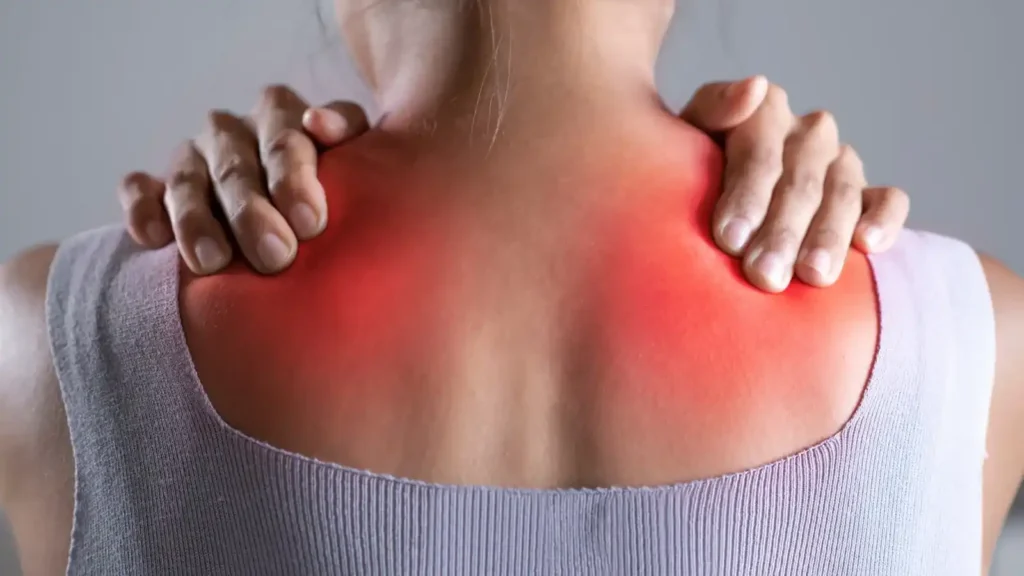
Here’s where things get confusing — because sometimes that pain in upper right arm between elbow & shoulder isn’t from the arm at all. It’s referred pain, which basically means the discomfort originates somewhere else (like your neck, shoulder blade, or even the chest) and travels along nerve pathways until it shows up somewhere unexpected.
Think of it like an electrical wire problem — the pain signal starts at one end but shows up at another. This is especially common with cervical spine issues, shoulder impingement, or even early stages of a frozen shoulder (adhesive capsulitis). You may feel tenderness in your upper arm, but the real issue lies higher up in the shoulder joint or along the brachial plexus.
Clues that it might be referred pain:
- Pain radiates from neck to shoulder to upper arm
- Tingling or numbness down the arm
- Pain worsens with neck movements, not arm activity
- Stretching or massaging the arm doesn’t fully relieve it
Typical sources of referred pain:
- Cervical disk herniation or nerve compression
- Frozen shoulder limiting shoulder capsule mobility
- Muscle tension in the trapezius or shoulder blade area
- Cardiac-related pain (especially if accompanied by chest tightness)
Here’s a simple comparison to help you distinguish it:
| Type | Origin | Pain Pattern | Treatment |
| Local Arm Pain | Muscles, tendons, joints | Focused in one spot | Rest, ice, physical therapy |
| Referred Pain | Neck, shoulder, or spine | Travels down arm | Posture correction, spinal alignment, nerve release exercises |
Pro Tip 🧠: One easy self-test — turn your head slowly from side to side. If the pain in your arm intensifies when your neck moves, you’re likely dealing with a nerve-related or referred pain issue, not a local muscle strain.
That’s your cue to explore cervical stretches, ergonomic training, or even a visit to an MSK (musculoskeletal) specialist who can pinpoint the source using diagnostic technology like an MRI or ultrasound.
VII. Cause #7: Poor Posture and Ergonomic Stress
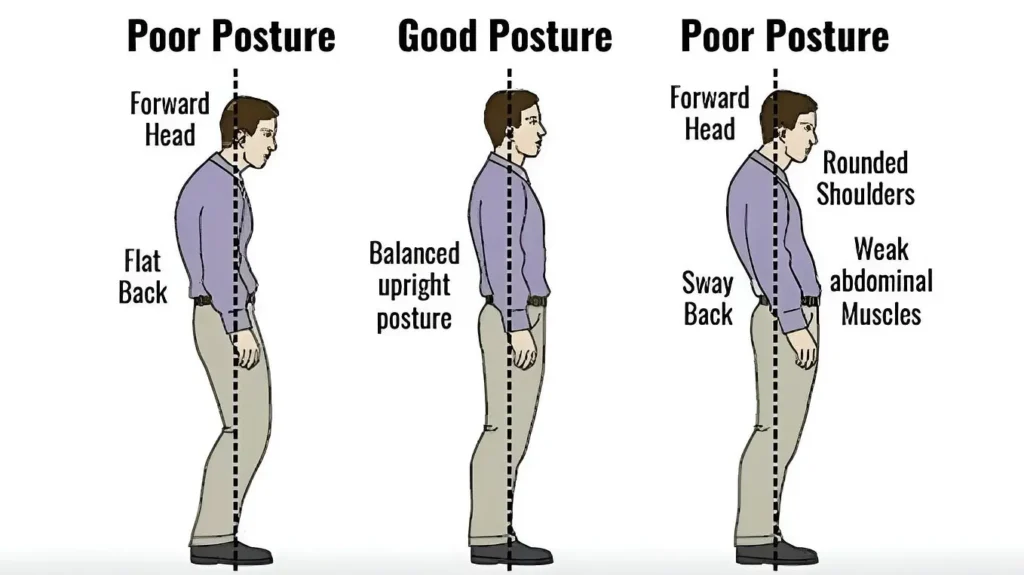
It’s amazing how something as ordinary as the way you sit or type can create lasting pain in upper right arm between elbow & shoulder. If you spend long hours at a desk or scrolling on your phone, chances are your shoulders are rounded forward, and your neck is slightly tilted down — a perfect recipe for muscle imbalance and tension.
Over time, that posture compresses nerves and strains the deltoid, trapezius, and rotator cuff muscles. These small stabilizing muscles work overtime trying to keep your shoulders aligned. When they fatigue, the discomfort creeps from the shoulder into the upper arm.
Common posture-related causes include:
- Slouching at your desk or looking down at a screen
- Driving long hours with shoulders slightly raised
- Using a mouse or phone predominantly with one arm
- Poor sleeping position, especially side-lying
Here’s what chronic ergonomic stress does:
| Posture Habit | Resulting Problem | Symptom Pattern |
| Rounded shoulders | Shoulder impingement | Pain and tightness spreading into upper arm |
| Forward head posture | Nerve compression | Tingling or numbness in arm |
| Leaning on one elbow | Local muscle fatigue | Dull ache between shoulder and elbow |
Pro Tip 💺: Adjust your workspace — keep your screen at eye level, elbows bent at 90°, and shoulders relaxed. If your job involves typing or lifting, stretch your pectoral muscles and upper back daily. Even short breaks (1–2 minutes of movement every hour) can make a world of difference for your arm and shoulder health.
VIII. Cause #8: Frozen Shoulder (Adhesive Capsulitis)
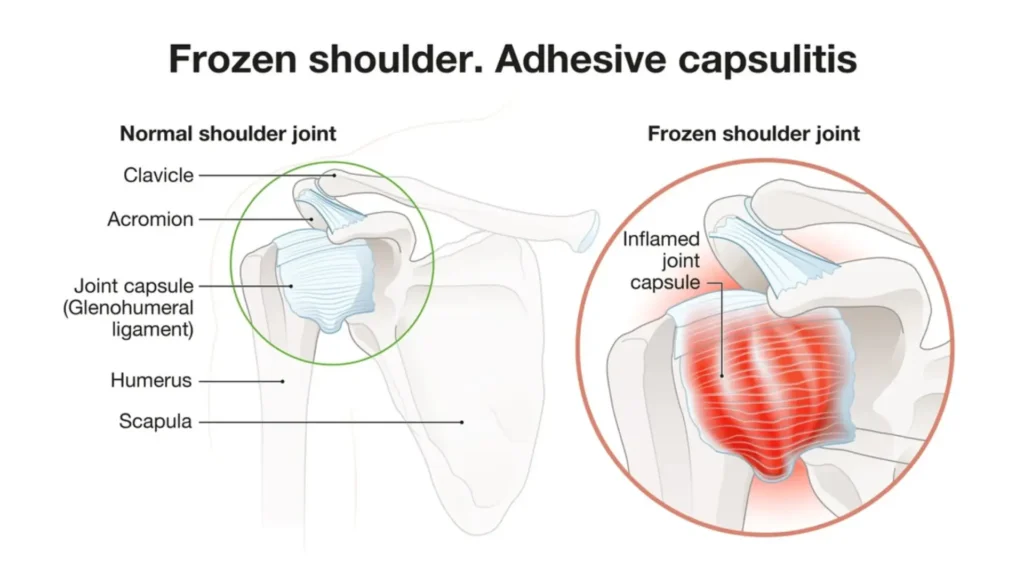
Frozen shoulder is one of those conditions that creeps up quietly and leaves you wondering how something so still can hurt so much. It’s another common reason for persistent pain in upper right arm between elbow & shoulder. In simple terms, frozen shoulder occurs when the connective tissue capsule around your shoulder joint thickens and tightens, limiting movement and causing stiffness.
It often follows an injury, surgery, or prolonged immobility (like wearing a sling). Sometimes, it appears without any clear reason — though diabetes, thyroid disorders, and hormonal changes can increase your risk.
Three distinct phases of frozen shoulder:
- Freezing phase: Gradual onset of shoulder pain that worsens at night.
- Frozen phase: Stiffness dominates, arm movement becomes limited.
- Thawing phase: Pain eases, and mobility slowly returns over months.
Symptoms to look for:
- Pain radiating into the upper arm and elbow
- Difficulty lifting your arm or rotating it behind your back
- Stiffness that worsens at night or early morning
- Weakness due to disuse and reduced blood flow
Treatment and recovery:
| Stage | Recommended Care | Goal |
| Early (Freezing) | Anti-inflammatory meds, gentle pendulum swings | Reduce pain and inflammation |
| Middle (Frozen) | Targeted physiotherapy, heat therapy | Improve joint mobility |
| Late (Thawing) | Gradual stretching, resistance band work | Regain full movement and strength |
Pro Tip 🧊: Don’t rush frozen shoulder recovery — forcing range of motion can worsen inflammation. Instead, use moist heat before stretches and ice afterward to calm irritation. Consistency in mild movement (not intensity) helps your shoulder “unfreeze” faster.
IX. Cause #9: Rotator Cuff Injury or Tear
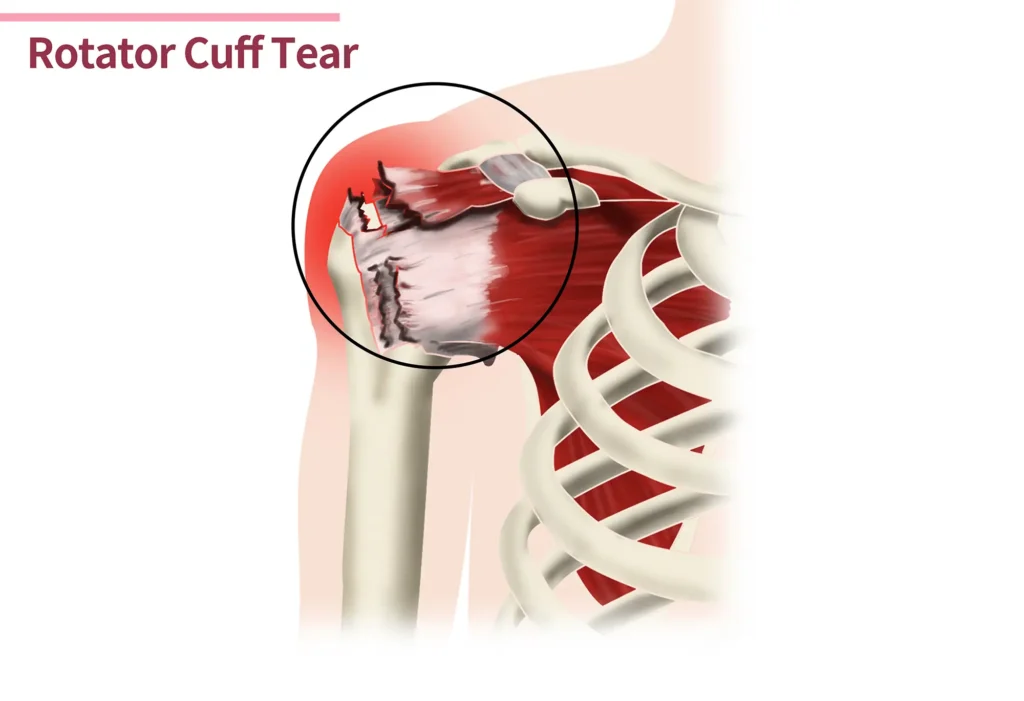
If you’ve ever tried to lift something overhead and felt that sharp, tearing kind of pain in upper right arm between elbow & shoulder, it could point to a rotator cuff injury. The rotator cuff is a group of four small muscles that stabilize your shoulder joint. When they’re strained, inflamed, or torn — even partially — you’ll feel weakness, limited motion, and persistent soreness that just won’t go away.
Rotator cuff injuries can come from sudden trauma (like catching a heavy object mid-fall) or slow wear and tear over time. They’re common among athletes, manual laborers, and anyone who performs repetitive overhead motions.
Typical symptoms include:
- Pain radiating from shoulder to upper arm
- Weakness when lifting or rotating the arm
- Clicking or crackling sounds with movement
- Night pain that worsens when lying on the affected side
Common types of rotator cuff injuries:
| Type | Description | Pain Severity |
| Tendinitis | Inflammation of the tendon fibers | Mild to moderate |
| Partial tear | Small rip in tendon tissue | Moderate to severe |
| Full tear | Complete separation of the tendon | Severe and disabling |
Pro Tip 🏋️♀️: Early rehab is key. Focus on low-resistance shoulder band exercises and gentle isometric holds. Avoid overhead presses or sudden jerky motions — they’ll only worsen the microtears. For chronic tears, an MRI can help confirm whether you need physical therapy or surgical repair.
X. Cause #10: Trapped Nerve or Tendonitis
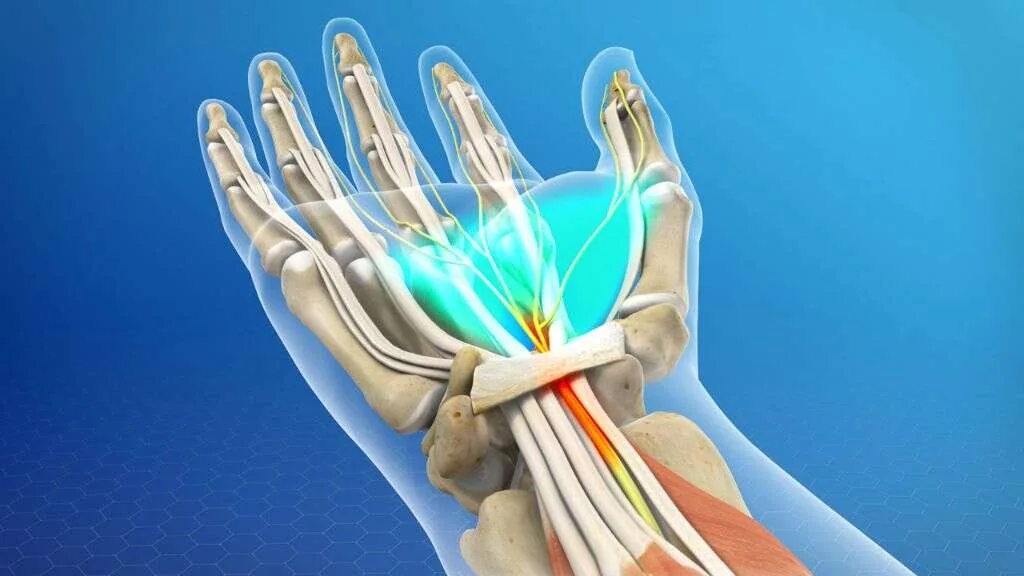
Sometimes the pain in upper right arm between elbow & shoulder feels electric — like a burning or tingling sensation that comes and goes. That’s a sign of nerve entrapment (most often involving the radial or axillary nerve). In other cases, it could be tendonitis, an inflammation of the tendons that connect muscles to bones. Both conditions mimic each other, and both can be just as frustrating.
How to tell them apart:
| Symptom | Likely Cause | Example |
| Tingling or numbness | Trapped nerve | Cervical nerve compression |
| Sharp pain on movement | Tendonitis | Biceps or deltoid tendon inflammation |
| Weak grip or muscle fatigue | Nerve-related | Pinched nerve in shoulder or neck |
| Soreness after repetitive use | Tendonitis | Overuse from sports or lifting |
Nerve compression can stem from postural strain, herniated disks, or shoulder impingement, while tendonitis often arises from repetitive lifting, bad form, or aging connective tissue.
Pro Tip ⚡: Try alternating heat and ice therapy — heat to relax tight muscles, ice to calm inflammation. Add nerve gliding exercises and gentle eccentric loading (slow lowering of light weights) to improve circulation and promote tendon healing.
If symptoms persist beyond a few weeks, a physical therapist can pinpoint whether it’s neural or tendon-related using simple mobility tests.
XIII. Diagnosis: How Doctors Identify the Root Cause
When you visit a clinic for pain in upper right arm between elbow & shoulder, the first step usually isn’t fancy technology — it’s conversation. A doctor, usually an orthopedic specialist or physical therapist, will ask when it started, what movements make it worse, and whether you’ve noticed tingling, swelling, or stiffness.
They’ll likely begin with a physical examination — testing range of motion, checking shoulder blade alignment, and gently pressing along the rotator cuff tendons or biceps tendon to pinpoint tenderness.
Sometimes you’ll be asked to lift or rotate your arm to see if certain angles reproduce the pain (which can hint at impingement syndrome or bursitis). If needed, imaging comes next.
Here’s a quick breakdown:
| Diagnostic Test | What It Detects | Why It’s Useful |
| X-ray | Bone spurs, arthritis, dislocation | Rules out fractures or degenerative joint changes |
| MRI | Soft tissue tears, rotator cuff injuries | Gives a detailed view of muscles and tendons |
| Ultrasound | Real-time movement, inflammation | Ideal for spotting bursitis or tendonitis |
| Nerve Studies (EMG) | Nerve compression or brachial plexus injury | Detects if your pain stems from the neck or peripheral nerves |
Before your appointment, it helps to track patterns — jot down when your pain appears (morning vs night), what movements hurt most, and any sensations like numbness or tingling. This log helps your doctor connect symptoms with possible causes like frozen shoulder, nerve impingement, or muscle strain.
Pro Tip 💡: When describing your upper arm pain, skip vague words like “it hurts.” Instead, say things like “it burns when I lift my arm” or “it feels stiff after sleeping.” That kind of detail makes diagnosis way faster.
XIV. Treatment Options and Home Remedies
Treatment really depends on what’s driving the pain in upper right arm between elbow & shoulder — but most cases respond well to a mix of rest, rehabilitation, and lifestyle tweaks. Doctors often start with nonsteroidal anti-inflammatory drugs (NSAIDs), corticosteroid injections, or physical therapy sessions designed to rebuild shoulder mobility and reduce inflammation in the rotator cuff muscles or biceps tendon.
At home, small things matter more than you’d think:
- Rest — give your shoulder joint a break from repetitive overhead motions.
- Cold Compress or Ice Pack — great for early swelling or tenderness.
- Heat Therapy — ideal once stiffness sets in.
- Gentle Stretching — doorway stretch, towel stretch, or wall slides to ease tension.
- Ergonomic Adjustments — if you work long hours at a desk, raise your screen and keep your elbows near your torso.
Natural Remedies That May Support Recovery:
- Turmeric, ginger tea, and omega-3s for reducing inflammation.
- Magnesium-rich foods for muscle relaxation.
- Collagen and vitamin D to strengthen tendons and joints.
Pro Tip 🌿: Pairing physical therapy with mindful posture correction makes recovery twice as effective. Many sports medicine experts agree that consistent shoulder blade squeezes and gentle strengthening can prevent recurring strain on the shoulder joint.
If your pain persists beyond a few weeks — or if you suspect a rotator cuff tear, nerve compression, or calcific tendinitis — your doctor may recommend MRI ultrasound or even orthopedic surgery as a last resort.
XV. Prevention and Long-Term Care
Once you’ve recovered from pain in upper right arm between elbow & shoulder, prevention becomes your long-term best friend. It’s not just about staying active; it’s about how you move. Keeping your shoulder muscles, biceps, and rotator cuff tendons balanced prevents overuse and future flare-ups.
Here’s what a shoulder-friendly routine might look like:
- Daily Mobility Drills: Shoulder rolls, pendulum swings, and scapular retractions.
- Strengthening: Light resistance band work to engage stabilizers and improve range of motion.
- Posture Reset: Check your sitting position every hour; your shoulders should stay aligned over your hips.
- Mindful Movement: Avoid jerky overhead motions or lifting objects awkwardly.
Lifestyle Habits That Help:
- Stay hydrated — joint tissues rely on fluid balance.
- Prioritize good sleep and stress relief; muscle tension often worsens under anxiety.
- Rotate workouts — balance push and pull exercises to prevent muscle imbalances.
Pro Tip 🧘♀️: Shoulder health isn’t just physical — it’s mental too. Practicing mindfulness, yoga, or gentle breathwork helps release the tension patterns that feed upper arm pain.
With steady care, awareness, and the right balance of rest and movement, most people regain full strength and freedom — and maybe even learn to appreciate how resilient the shoulder really is.
🩺 Conclusion
When you’re dealing with pain in upper right arm between elbow & shoulder, it’s not just about the ache itself — it’s your body’s quiet way of saying something’s off. That pain could stem from muscle tension, rotator cuff irritation, or even nerve compression in your neck or shoulder. Each has its own rhythm, its own message, and learning to read it can help you respond with the right kind of care.
The best thing you can do is listen closely to how your pain behaves — when it starts, what movements make it worse, and how it feels over time. That awareness helps you tell the difference between something simple, like a strained muscle, and something deeper, like inflammation or referred pain from the spine.
Managing pain in upper right arm between elbow & shoulder usually starts with rest, gentle stretches, and patience. Sometimes your body just needs a break to heal itself. But if the pain lingers, spreads, or disrupts your sleep, that’s when it’s smart to get checked by a healthcare professional who can pinpoint the cause.
Long term, what really makes the difference is consistency — maintaining good posture, moving often, and strengthening your shoulders bit by bit. Those small habits build resilience, helping your arms stay strong, balanced, and free from that persistent, nagging ache.
💬 Frequently Asked Questions
1. Why do I have pain between my shoulder blades while pregnant?
It’s often caused by posture changes, muscle strain, or hormonal shifts loosening your joints. Gentle stretches and rest usually help. If pain persists or worsens, mention it to your doctor to rule out nerve compression or gallbladder strain.
2. What does it mean when a woman’s right upper arm hurts?
It could stem from muscle strain, tendon inflammation, or even nerve compression. Sometimes, hormonal or circulatory changes also play a role. If it’s ongoing or spreads to your shoulder and neck, a physical therapist can help assess posture and tension patterns.
3. How to know if right arm pain is serious?
If pain is sudden, sharp, or paired with chest tightness, dizziness, or numbness — seek medical help immediately. Otherwise, monitor for swelling or weakness. Persistent pain that interferes with sleep or arm movement may need imaging tests like MRI or ultrasound.
4. Can pain in the right arm be heart-related?
Yes, though it’s less common than left arm pain. Referred pain from heart issues can radiate to the right side, especially during cardiac distress. If you feel pressure, heaviness, or shortness of breath along with it, treat it as a possible emergency.
5. What are 5 warning signs of a possible problem during pregnancy?
Severe abdominal pain, persistent headache, vision changes, swelling in hands or face, and sharp shoulder or arm pain may indicate complications. Contact your healthcare provider immediately — early attention can prevent serious pregnancy-related risks.
6. How soon does shoulder pain start in ectopic pregnancy?
Shoulder or upper arm pain can appear once internal bleeding irritates the diaphragm — usually between 4–12 weeks of pregnancy. If this pain feels sharp, constant, or comes with dizziness, seek urgent medical evaluation.
7. What disease starts with arm pain?
Heart attack, rotator cuff injuries, rheumatoid arthritis, or nerve compression disorders like cervical radiculopathy can all begin with arm pain. Getting a proper diagnosis helps prevent long-term complications, especially if the pain is unexplained.
8. Can right arm pain be a stroke?
Yes — if it’s sudden and accompanied by weakness, numbness, or difficulty speaking, it might indicate a stroke. Get emergency help right away. Even mild weakness or clumsiness on one side of the body deserves medical attention without delay.
9. Why do I have a stabbing pain in my upper right arm?
It’s often due to a pinched nerve, muscle tear, or inflammation in the rotator cuff tendons. Ice, rest, and posture correction can help relieve it. If pain radiates toward your shoulder blade or elbow, it might suggest tendonitis or nerve irritation.
10. When should I see a doctor for upper arm pain?
If the pain lasts over two weeks, limits movement, or comes with numbness, swelling, or chest symptoms, it’s best to get checked professionally. Early evaluation helps rule out serious issues like rotator cuff tears, nerve compression, or circulatory problems.

